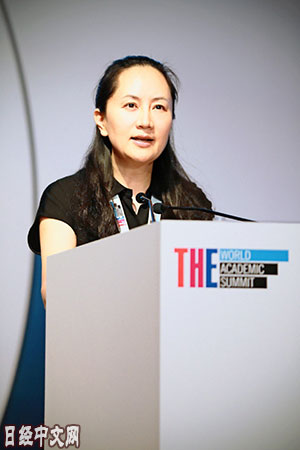孟晚舟向日本經濟新聞投稿
2019/01/25
華為技術副董事長兼首席財務官(CFO)孟晩舟向日本經濟新聞(中文版:日經中文網)投稿。
孟晚舟是華為創始人任正非的女兒,美國提出因有參與向被經濟制裁的伊朗出口産品的嫌疑,要求加拿大警方對其實施逮捕。孟晚舟2018年12月初在加拿大被逮捕後,目前被保釋。美國政府的方針是要求加拿大進行引渡,中國對此表示出強烈不滿,表示根據美國的行動會採取相應措施。
此前英國牛津大學決定不再接受華為的研究資金,孟晚舟在投稿中稱:「華為從未想過從合作夥伴那裏獲取各種專利或研究成果」,表示今後將繼續資助能帶來科學與技術進步的基礎研究。
據悉,此次孟晚舟的投稿是整理了孟晚舟2018年9月在新加坡演講時的內容,沒有提及逮捕一事。
孟晚舟投稿全文如下:
華為副董事長孟晩舟的投稿全文
誕生於中世紀歐洲的大學在數個世紀的時間裏,主要是為了將那個時代的知識傳播到下一代而存在。人類知識的發展,當時主要是通過在同業公會制之下工作的人們來積累。但産業層面的經驗積累和大學研究很少産生交集。
 |
| 孟晚舟 |
但是,學術界和産業界的關係在工業革命的時代發生改變。大學從單純普及知識的「場所」變為了追求「知識」最前線的場所。詹姆斯·瓦特開發出近代蒸汽機,是在格拉斯哥大學負責修理效率低下的初期階段蒸汽機之時。蒸汽機隨後在製造業和交通工具等得到廣泛利用。
到了1940~1950年代,民間企業和研究機構開始在基礎研究領域發揮一定的作用。美國電話電報公司(AT&T)的貝爾實驗室開發出電晶體、雷射器和資訊理論。隨著美國德州儀器(TI)開發出積體電路,「摩爾法則」的時代到來。
現在,大學和企業前所未有地緊密結合。大學在人工智慧(AI)領域走在基礎理論研究的最前端,而谷歌、Facebook、特斯拉和華為等技術領先企業則正致力於理論的實用化。
18萬名華為員工的近半數參與研發。最近10年的研發費用超過600億美元,計劃今後數年投入150億~200億美元。
我們要作為IT企業取得成功並生存下去,取決於研發部門能否準確地預測通信技術的發展。為了看清未來,要培育開放的企業文化,我們一直鼓勵員工,推崇「一杯咖啡吸收宇宙能量」。這句話的含義是不要只顧著工作,要偶爾拿出時間,大家聚在一起,彼此讓各種思想相互碰撞,這一點也非常重要。
為了培育和外部的合作關係,啟動了「華為創新研究計劃(HIRP)」,為全世界大學和研究機構構建了虛擬的咖啡吧,在這裡,大家可以交流各種思想。首先於2010年在歐洲啟動。通過這個計劃為最具可能性的方案提供資金。通過HIRP,與全球前100的大學和30多個國家的國家級研究機構的學者緊密合作。
為了更廣泛地支援基礎研究方向與華為業務相一致的科學家們,我們在2014年擴充了HIRP。由HIRP支援的項目數超過1200個,許多都已經成功實現商業化。例如華為與德國慕尼黑工業大學聯合研發的降噪技術已經用到手機上。另外德國國家工程院院士Josef Nossek教授提出將無線技術應用於光通信的構想,大幅降低了光傳輸産品所用晶片的功耗。
有一部分人似乎心存疑慮,但華為從未想過從合作夥伴那裏獲取各種專利或研究成果。英國牛津大學決定新的項目今後不再接受來自華為的資金援助,但我們的目的只是從研究人員的成功與失敗中學習。
這種開放式的合作是消除橫亙在科學與商業應用之間鴻溝的唯一方法。為此,不僅僅需要資金,還要保持耐心。因為有些基礎性的理論投入到實際應用要花上數十年時間。
只有大學與企業開始相互合作,才能消除這種時間性的阻隔。大學不進行基礎研究,産業就沒有理論基礎。如果沒有産業界、學術界的知識就只能封閉在象牙塔裏。
華為之所以向各種各樣的大學提供資助,就是因為認識到大學裏追求的科學研究就像燈塔一樣照亮未來的發展方向。科學家是燈塔的所有者,研究成果可以按照研究者自身喜好的方向實現商業化。
華為今後將繼續資助能帶來科學與技術進步的基礎研究。這樣的合作活動不僅僅有助於華為的業務活動,還將給社會和整個産業做出貢獻。
注:孟晚舟2018年12月被加拿大當局逮捕,現在被保釋。孟晚舟本人投稿的事實和內容有報道的價值,因此刊登全文。投稿原文為英語,日經中文網刊登的中文內容由日語原稿翻譯而成。
(華為副董事長孟晚舟投稿的英文全文在下一頁)
Why Huawei values collaboration with universities
Meng Wanzhou
Universities originated in medieval Europe, where for centuries they existed mainly to pass existing knowledge on to subsequent generations. Advances in human knowledge were driven primarily by craftsmen working in guilds. Industrial craftsmanship and university research rarely crossed paths.
 |
| Meng Wanzhou |
That changed during the Industrial Revolution, when universities went from simply disseminating knowledge to pushing back its frontiers. James Watt developed the modern steam engine while repairing an inefficient early model at the University of Glasgow. His refinements led to the widespread use of steam power for manufacturing and transport.
Private companies and institutes began playing a role in basic research in the 1940s and 1950s. AT&T's Bell Labs invented the transistor, the laser, and information theory while an engineer from Texas Instruments ushered in the era of Moore's Law by inventing the integrated circuit.
Today, universities and companies are collaborating more closely than ever. Universities are leading the charge in basic theoretical research on artificial intelligence while leading companies like Google, Facebook, Tesla and Huawei Technologies are putting scholars' theories to practical use.
Nearly half of Huawei's 180,000 employees are engaged in research and development. Over the past decade, we have invested $60 billion in R&D and plan to spend $15 billion to $20 billion annually over the coming years.
As a tech company, our success -- indeed, our survival -- depends on how accurately our R&D predicts the evolution of future communications technology. To get it right, we foster a culture of openness, encouraging employees to "absorb the energy of the universe over a cup of coffee." This is a way of saying they should take time out of the work day to get together and bounce around ideas.
To foster collaboration externally, the Huawei Innovation Research Program provides a virtual coffee shop where we can exchange ideas with universities and research institutes around the world. First launched in Europe in 2010, the program funds proposals that offer the greatest potential. Through HIRP, we work closely with most of the world's top 100 universities and with scholars at 50 national laboratories in more than 30 countries.
In 2014, we expanded HIRP to support a wider range of scientists whose basic research aligns with our business. To date, the program has funded 1,200 projects, many of which have successfully been commercialized. For example, the noise canceling technology that we developed together with the Technical University of Munich is used in mobile phones. We also work closely with Professor Josef Nossek, a member of the German Academy of Science and Engineering, whose application of wireless concepts to optical communications has reduced the power consumption of chips used in certain optical transmission products.
Contrary to what some have alleged, Huawei is not after our partners' patents or research results. While we have noted Oxford University's decision to decline further funding for new projects from Huawei, our goal is only to learn from researchers' successes and failures. This type of open collaboration is the only way to close the gap between basic science and its commercial application. It requires not only funding but patience, as the journey from a basic theory to its practical adaptation may take decades.
We can only bridge this divide when universities and companies collaborate. Without basic research by universities, industrial development would lack theoretical foundations; without industry, knowledge would remain cloistered in the ivory towers of academia.
Huawei supports universities so that scientific research can be a lighthouse that illuminates a path toward the future. Scientists own the lighthouse, allowing them to commercialize the fruits of their research however they like.
Huawei will continue funding basic research that leads to advances in science and technology. This collaboration will benefit not only our own commercial efforts, but industry and society as a whole.
Meng Wanzhou, also known as Sabrina Meng, is chief financial officer of Huawei Technologies.
This article has been adapted from an unpublished speech Meng delivered last year in Singapore and was provided to the Nikkei Asian Review following Oxford's decision this month to decline funding from Huawei for any new projects. Meng is under house arrest in Vancouver, Canada pending extradition to the U.S.
版權聲明:日本經濟新聞社版權所有,未經授權不得轉載或部分複製,違者必究。
